Address any questions or comments regarding this newsletter to the individual authors listed after each article or to its editors, Nathan Johanning, 618-939-3434, njohann@illinois.edu or Bronwyn Aly 618-695-6060, baly@illinois.edu. The Illinois Fruit and Vegetable News is available on the web at: http://ipm.illinois.edu/ifvn/. To receive or be removed from email notification of new postings of this newsletter, contact Nathan Johanning or Bronwyn Aly at the phone numbers or email addresses above.
In This Issue:
Upcoming Programs ((listings for beginning and established growers))
News & Announcements ((Condolences, Upcoming Meetings in Missouri for Specialty Growers, Grower Survey on Facebook Usage))
Regional Reports ((west central Illinois, southern Illinois, Dixon Springs))
Fruit & Vegetable Production & Pest Management ((Sweet Snacking Pepper Variety Trial, Spotted Lanternfly Webinars, Chilling Hour Accumulation for Perennial Fruit Crops))
Upcoming Programs
Check the Illinois SARE calendar for a full list of programs and links for registration. http://illinoissare.org/ and http://illinoissare.org/calendar.php Also see the University of Illinois Extension Local Food Systems and Small Farms Team’s website at: http://web.extension.illinois.edu/smallfarm/ and the calendar of events at http://web.extension.illinois.edu/units/calendar.cfm?UnitID=629.
- 2019 Small Farms Winter Webinar Series, Thursdays at noon, from January 24 –April 4, 2019.
Registration is open for the 2019 series with a whole new set of topics! It’s easy (and FREE!) to register for the Small Farms Winter Webinars. Sign up for as many as you want at https://go.aces.illinois.edu/SmallFarmWinterWebinar. We’ll send you a webinar reminder, log-on instructions, and how to access the archived recording. If you do not have broadband internet capable of streaming video, call your local Extension office to see if they can offer live viewing.
Topics for this year’s series are:
Jan. 31 2018 Updates on Illinois Cottage Food Law
- Mary Wright, Drusilla Banks, and Jenna Smith, University of Illinois Extension Nutrition and Wellness Educators
Feb. 7 Five Years In: What Do We Really Know about Growing and Processing Industrial Hemp?
- Thomas Keene, University of Kentucky Agronomy Specialist and Hemp Extension Associate
Feb. 14 Intro to Digital Marketing in the Local Food System
- Grant McCarty, University of Illinois Extension Local Food Systems and Small Farms Educator
Feb. 21 FSMA Produce Safety Exemptions and Guidance: What You Need to Know for 2019
- Zack Grant, University of Illinois Extension Local Food Systems and Small Farms Educator
Feb. 28 Maximizing Your Production: Succession and Companion Planting
- Laurie George, University of Illinois Extension Local Food Systems and Small Farms Educator
Mar. 7 Healthy Soil Produces Healthy Vegetables
- James Theuri, University of Illinois Extension Local Food Systems and Small Farms Educator
Mar. 14 The Best Practices for Maintaining Healthy Bee Hives
- Doug Gucker, University of Illinois Extension Local Food Systems and Small Farms Educator
Mar. 21 Reducing Damage to Livestock and Specialty Crops from Wildlife
- Dave Shiley, University of Illinois Extension Local Food Systems and Small Farms Educator
Mar. 28 Agroforestry for Diversification on Small Scale Farms
- Bill Davison, University of Illinois Extension Local Food Systems and Small Farms Educator
Apr. 4 ABCs of Tomato Production
- Bronwyn Aly, University of Illinois Extension Local Food Systems and Small Farms Educator
- 2019 Southwestern Illinois Tree Fruit School, Thursday, February 7, 2019, Knights of Columbus Hall, Hardin, IL. https://web.extension.illinois.edu/registration/?RegistrationID=19595 For current research-based information on growing tree fruits, attend the 2019 Tree Fruit School. This year's program features a wide range of topics to help you meet the challenges of commercial fruit production in Southwestern Illinois. Industry representatives will also be on hand to talk about their latest products and services. Topics will cover updates on peach and apple insect and disease management, apple rootstocks, plus much more! Jeff Broom from Broom Orchard will discuss the 2018 year in review. Registration includes one copy of the 2019 Midwest Spray Guide. Advanced registration by February 1 is $40.00 per person, lunch included. Orchards sending more than one employee: $40.00 for the first person and $30.00 for each additional person. Lunch is included. Registration at the door is $50.00 per person, lunch included. NEW THIS YEAR: Registration starts at 7:30 am, the program begins at 8:00 am and runs until 4:15 pm
- 2019 Southern Illinois Fruit & Vegetable School, Friday, February 8, 2019, Doubletree Meeting & Event Center, 222 Potomac Blvd (formerly Holiday Inn) Mt. Vernon, IL. This year, the program will feature three separate tracks to address vegetable, small fruit and tree fruit production; bringing you an informative, practical, and up-to-date research-based information to address the challenges of growing fruit and vegetables commercially in Southern Illinois. Advanced registration is $40.00 per farm, and a copy of the 2019-2020 Midwest Fruit Pest Management Guide OR the 2019 Midwest Vegetable Production Guide for Commercial Growers will be included in the cost of registration. Advanced registration is preferred and is available online https://web.extension.illinois.edu/mms/ or by mail. The deadline for receipt of advanced registration is February 1, 2019. Registration at the door is $50.00.
- • Produce Safety Alliance Grower Training Course, Thursday, February 7, 2019 and Friday, February 8, 2019, Pembroke Public Library, 13130 East Central, Hopkins Park, IL 60958. Fruit and vegetable growers and others interested in learning about produce safety, the Food Safety Modernization Act (FSMA) Produce Safety Rule, Good Agricultural Practices (GAPs), and co-management of natural resources and food safety. The PSA Grower Training Course is one way to satisfy the FSMA Produce Safety Rule requirement outlined in §112.22(c) that requires ‘At least one supervisor or responsible party for your farm must have successfully completed food safety training at least equivalent to that received under standardized curriculum recognized as adequate by the Food and Drug Administration.’ Total cost to attend the PSA Grower Training Course is $145. The cost will include PSA Grower Training Manuals ($50) and a Certificate of Course Attendance from AFDO ($35). Other expenses will be for meals, beverages and room rental. To register for the training, visit this website: https://web.extension.illinois.edu/registration/?RegistrationID=19761 or visit the Extension Office at 1650 Commerce Dr., Bourbonnais, IL 60914 to submit your payment. For more information, call 815-933-8337 or email James Theuri at jtheu50@illinois.edu or Carolyn Smith at cls@ctsmithlp.com.
- Produce Safety Alliance Grower Training Course, Thursday, February 14, 2019, 8 a.m. to 5 p.m. Spoon River College Community Outreach Center, 2500 E. Jackson, Macomb, IL 61455. The registration deadline for this training is February 2, 2019. To register visit https://web.extension.illinois.edu/registration/?RegistrationID=19601. For more information contact Laurie George at (618) 242-0780 or at ljgeorge@illinois.edu.
Conferences and Schools
Midwest Winter Production Conference
February 11-12, 2019
Lincoln University Carver Farm and local farms, Jefferson City
http://www.webbcityfarmersmarket.com/grower-training.html
Missouri Blueberry School
February 22-23, 2019
MSU Darr Center and area blueberry farms, Springfield
http://extension.missouri.edu/blueberry/
Missouri Tomato School
May 30-31, 2019
Lincoln University Carver Farm and local farms, Jefferson City
http://www.webbcityfarmersmarket.com/grower-training.html
Riverhills Elderberry Conference
June 13-15, 2019
Lincoln University Carver Farm and local farms, Jefferson City
https://www.riverhillsharvest.com/comprehensive-elderberry-workshop-s
News & Announcements
Condolences
On behalf of University of Illinois Extension, we extend our deepest sympathy to the family and friends of Robert “Bob” Edwards, Sr., who passed away Monday, January 21st at the age of 90. Bob founded Edwards Apple Orchard in Poplar Grove, IL with his wife Betty in 1964. Bob was also inducted to their Hall of Fame by the Illinois State Horticulture Society.
The visitation will be Friday, January 25 at the Poplar Grove United Methodist Church from 4-8 pm, 105 E Grove St, Poplar Grove, IL 61065, followed by a funeral service the following day at the church Follow this link for the obituary: https://andersonfcs.com/obituaries/robert-bob-m-edwards/.
Upcoming Meetings in Missouri for Specialty Crop Growers
During one of his presentations at the 2019 Illinois Specialty Crops, Agritourism & Organics Conference, Patrick Byers, Commercial Horticulture Field Specialist with Missouri Extension, mentioned some of the upcoming meetings and workshops being offered this coming year. He provided the following list which may be of interest to many of the IFVN subscribers.
Workshops and Field Days
Hops Field Day
August 6, 2019
Bradford Research Farm, Columbia
Pawpaw Field Day
September 20, 2019
MU Southwest Research Center, Mount Vernon
Blackberry Workshops
Versailles, April 3, 2019
Kirksville, April 5, 2019
Mount Vernon, July 9, 2019
Kansas City, June TBA 2019
Apple Grafting Workshops
Springfield, March TBA
Versailles, April 3, 2019
Kirksville, April 5, 2019
For information on any of these meetings, please contact:
Patrick Byers, Commercial Horticulture Field Specialist Webster County MU Extension 417-859-2044 byerspl@missouri.edu
Grower Survey on Facebook Usage
My name is Jarai Carter, a doctoral student in Informatics at the University of Illinois at Urbana-Champaign. For my dissertation, I intend to investigate why those in the farming community use Facebook and how this social media platform helps them out in their farming tasks. I am specifically interested in the opinions of those who are at least 18 years old and are subscribed to subscribed to an Illinois Extension email list. No Facebook experience is necessary to participate. Might I impose upon you to participate in this study?
As a participant, you will be asked to respond to a survey questionnaire, which should take no longer than 45 minutes to complete. Returning a completed questionnaire makes you eligible to be entered into a $50 Amazon.com gift card drawing.
Should you decide to participate, please follow this link to the survey: https://illinoisaces.co1.qualtrics.com/jfe/form/SV_exO6gKkqs3Mr0Vv
This survey will be available through 01-31-2019 at 11:59 p.m.
If you have questions about this project, you may contact me at carter31@illinois.edu, or the principal investigator, Dr. Lulu Rodriguez, at lulurod@illinois.edu.
If you have any questions about your rights as a participant in this study, please contact the University of Illinois Office for the Protection of Research Subjects at 217-333-2670 or via email at irb@illinois.edu.
Thank you for taking the time to assist me with this study.
Regional Reports
From west central Illinois… Up into the first part of January, farmers were lamenting that the ground had yet to freeze, which was making any fieldwork difficult. Now the ground is certainly frozen, but there is about a foot of snow on top. In Macomb, we’ve had no shortage of precipitation this winter and we should hopefully go into spring with replenished soil moisture levels.
It has been a few weeks since I’ve checked under the plastic on the plants. There is a knee-high drift between me and the high tunnel and low tunnels, and I haven’t had the proper motivation to blaze a trail in the snow. Today I took the plunge for you, the reader. I could only get into the high tunnel. Yesterday it rained buckets, and now it is currently 21 degrees F, with a predicted low of 9 degrees F tonight. Needless to say, the low tunnel plastic is frozen solid to the ground. The plants are on their own. I don’t have much happening in the low tunnels. Carrots, spinach, and kale are my remaining crops and I will assume they are holding nicely under the plastic.
There is even less going on in the high tunnel. My Swiss chard finally got hit by the frigid temperatures last week and are no more. I have been wanting to sow carrots in the high tunnel for January, but the snow, ice and now frigid temperatures have kept me inside.
This is good seed catalog weather. While hunkered down near the heater, I’ve thumbed through several catalogs, tempted by all the new varieties and odd crops I’d like to try my hand at growing. For those growing for a living, there is a risk in which crops you pick for market. In repeated studies, researchers have found two indicators of success for crop selection. The first indicator is to have a diversified mix of fruits and vegetables, selling 8 to 12 different products on the stand at any time. The second indicator is to specialize in one crop and become known as the best grower of that item.1 In my area, there is little competition for the title “Kale King!” Perhaps I’ve found my niche…
We will be hosting an upcoming Produce Safety Alliance training on February 14 at Spoon River Outreach Center in Macomb. This training is one way to satisfy compliance for the Food Safety Modernization Act (FSMA). Registration can be found HERE.
1 Source: Managing Risk with High Tunnels. Minnesota High Tunnel Production Manual for Commercial Growers. 2012
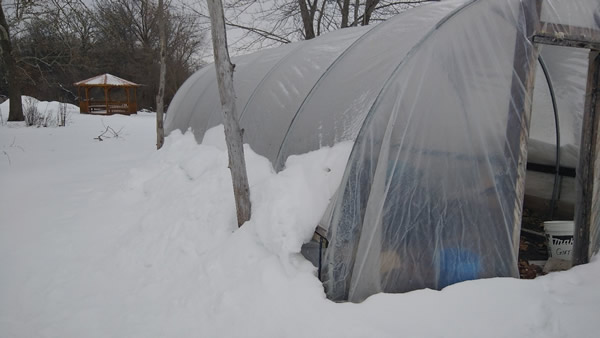
My old high tunnel has always done well shedding snow. This last snowfall was followed by rain and then ice. Still things are holding together!
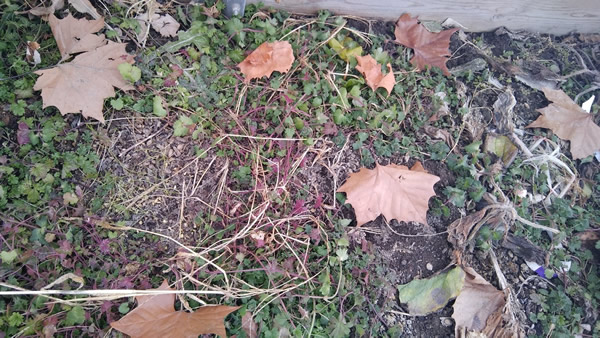
Winter annual weeds are a recurring problem in the high tunnel. Some weed pulling is in my future. Photos: C. Enroth.
Chris Enroth (309-837-3939; cenroth@illinois.edu)
From southern Illinois… It has definitely felt and looked like winter around southern Illinois the last few weeks. Although we have had a few days in the 40s or 50s here and there, for the most part we have been in the 30s and low 40s for highs. We have had two main rounds of snow that have hit the area. The first came the afternoon of Friday, January 11 as some of us were driving home from the Specialty Crops Conference in Springfield. We had about 5” of a very heavy wet snow. This is the same system that dumped near record amounts of snow to St. Louis and north with somewhere between 12-16” in the end. The following weekend we got hit again this time with rain which then turned to sleet and then snow mid-day on Saturday, January 19. We ended up with a layer of sleet and then about 4” of a light fluffy snow by evening. The ground was not froze when this system hit and soils are beyond saturated so most of the snow was melting from below. Creeks and rivers are filling up as our soils can’t hold much of any more additional moisture although no major flooding yet. We also had some rain yesterday (1/23). This is the most saturated I have seen the soil during the winter in a few years. The ground has not been frozen much although this morning (1/24) it was down to about 22˚ and so the ground was froze a little on top.
Today is one of the few days lately we have seen at least some sun, but with afternoon more clouds are rolling in. The forecast has us staying between the 20-40s for highs with a few below freezing days and in the next week. There is not much going on out in the field aside for some pruning out in the orchards. In our high tunnel, carrots, broccoli, and greens are still growing. The overall growth rate has been slow, but the October planted greens are finally getting close to harvestable size. Arugula has been way more vigorous than the spinach or leaf lettuce. The broccoli is doing well and the early planting now has some small heads formed. The lows in the teens and 20s have been hard on it; however, it still is doing well and will pull through with some warmer temperatures as the heads develop more.
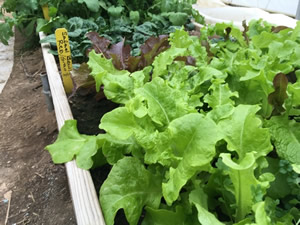
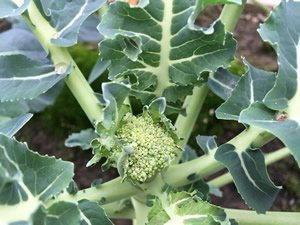

Pictures from the Jackson Co. High Tunnel. Lettuce, spinach and arugula (top left), broccoli (bottom left), and carrots (top right). Photos: N. Johanning.
Nathan Johanning (618-687-1727; njohann@illinois.edu)
From Dixon Springs Ag Center…Not much happening with the high tunnels at DSAC during these cold winter days. We have been deligent with watching weather fronts that have come through in the past couple of weeks, and luckily, not needing to do any snow removal on the tunnels. Our to do list is ready and waiting for days that will allow progress. We have finally experienced our coldest winter days this past weekend. Seeds have been ordered for the 2019 growing season.
Bronwyn Aly (618-382-2662; baly@illinois.edu)
Fruit & Vegetable Production & Pest Management
Sweet Snacking Pepper Variety Trial
Variety trials were conducted in the 2018 growing season to evaluate the performance of three different varieties of sweet snacking peppers. A no-till trial with 3 randomized replications was conducted at the Murphysboro office. An observational trial using the same 3 varieties was conducted in the Murphysboro high tunnel. The no-till trial was transplanted May 25, 2018 and the high tunnel trial was transplanted May 29, 2018.
No-till Transplants in the no-till trial were set 1 ft apart in a single row with 8 plants per plot. The trial had three randomized replications. Fruits were evaluated as either marketable or cull. Plants were harvested 7 times from July 27 – October 14. The harvest season was broken into early-season July 27 - August 9, mid-season August 23 - September 20, and late-season October 5 - October14.
High tunnel Transplants were set 1 ft apart in a staggered double row. This trial was observational, with one replication. Plants were supported by string to prevent laying over. Fruits were evaluated as either marketable or cull. 6 harvests were made from August 9 – October 22. The harvest season was broken into early-season August 9, mid-season August 23 – September 21, and late-season October 8 – October 22.
All fertility and pest management applications were made according to the recommendations given in the Midwest Vegetable Production Guide, 2018.
A special thanks to Johnny’s, Seedway, and Rupp’s for donating the seed for this trial and to Katie Bell our Extension Intern who managed the trials and data collection.
The results of the trials are listed in the following chart. Varieties are listed in descending order based on total marketable yield.
Early-Season (7/27-8/9) |
Mid-Season (8/23-9/20) |
Late-Season (10/5-10/14) |
Total No. |
Total Yield |
Fruit Size |
Total Culls |
|
No-Till |
--------------------------------------Marketable------------------------------------------ |
||||||
Variety |
------------(fruits per plant)-------------- |
(fruit per plant) |
(lbs per plant) |
(oz.) |
(lbs/ plant) |
||
Sweetie Blend |
5.8 |
36.0 |
10.6 |
52.5 |
1.8 |
1.3 |
0.6 |
Lunch Box Mix |
1.8 |
36.8 |
14.6 |
53.2 |
1.5 |
1.1 |
0.9 |
Yummy Mix |
6.1 |
28.4 |
8.6 |
43.1 |
1.4 |
1.3 |
0.8 |
High Tunnel |
Early-Season (8/9) |
Mid-Season (8/23-9/21) |
Late-Season (10/8-10/22) |
|
|||
Sweetie Blend |
3.8 |
34.3 |
9.3 |
47.4 |
2.0 |
1.4 |
0.2 |
Yummy Mix |
1.4 |
25.3 |
5.6 |
32.3 |
1.3 |
1.5 |
0.2 |
Lunch Box Mix |
2.8 |
23.1 |
4.2 |
30.1 |
1.2 |
1.4 |
0.2 |
*descending value based on total marketable yield |
|||||||
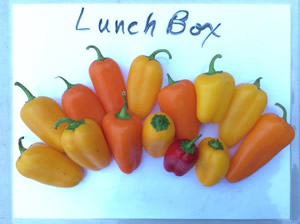
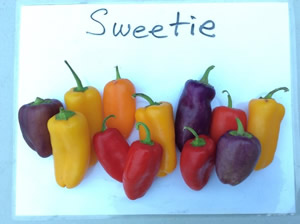

Nathan Johanning (618-687-1727; njohann@illinois.edu)
Spotted Lanternfly Webinars
In conjunction with the New York State IPM Program and the Department of Agriculture and Markets, the Northeastern IPM Center will host a collection of webinars, titled "Spotted Lanternfly Basics."
Each webinar will focus on, and be tailored to, a specific commodity group:
- Spotted Lanternfly Basics for Hops, Berry, and Vegetable Growers (Feb. 26, 2019, 10:00 a.m.)
- Spotted Lanternfly Basics for Grape and Apple Industries (Feb. 26, 2019, 1:00 p.m.)
- Spotted Lanternfly Basics for Christmas Tree Growers (Mar. 4, 2019, 10:00 a.m.)
- Spotted Lanternfly Basics for Nursery, Greenhouse, and Landscape Industries (Mar. 4, 2019, 1:00 p.m.)
All webinars will follow a similar format that covers spotted lanternfly biology, identification, and hosts, monitoring and management strategies, and a regulatory update. While the content may be relevant to audiences throughout the Northeast, management practices covered will be specific to New York. Participants will be encouraged to ask questions.
For more information and registration links, go to: http://neipmc.org/go/mYey
The NEIPMCommunication-L list is owned by the Northeastern IPM Center, 340 Tower Road, Cornell University, Ithaca NY 14853.
The Northeastern IPM Center fosters the development and adoption of integrated pest management, a science-based approach to dealing with pests that brings economic, environmental, and human health benefits. We use the list periodically to publicize IPM funding opportunities, research and extension projects, and IPM news and information.
To join or unsubscribe from the list, please send a request via e-mail to NortheastIPM@cornell.edu
Kelly Estes (217-333-1005; kcook8@illinois.edu )
Chilling Hour Accumulation for Perennial Fruit Crops
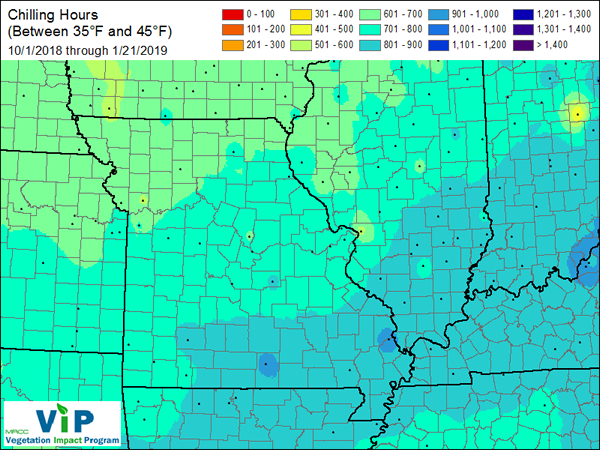
From the Midwestern Regional Climate Center https://mrcc.illinois.edu/VIP/indexChillHours.html
Does unseasonably warm weather in the middle of winter cause fruit trees to “wake up” too early? As with all things in nature, it all depends. Most trees from temperate climates require the accumulation of winter chill (500 and 1,500 chill hours) and subsequent heat during their dormant phase to resume growth and initiate flowering in the following spring. Chilling hours are the number of hours of exposure to about 45°F, and are measured from leaf drop in autumn until mid-February to early March, and are specific down to cultivar. Chilling hours for fruit plants usually accumulate between 35°F and 55°F, with 45° considered optimal. The Midwest Regional Climate Center is close to this ideal; they assume if the temperature at each station at the top of the hour is greater than or equal to 35°F and less than or equal to 45°F (35°F <= T <= 45°F), then the station’s season’s chilling hour accumulation is increased by 1 unit. As of January 21, 2019, much of the collar counties of St Louis, with a few exceptions, have accumulated at least 701-800 chill hours so far. This means any temperate woody perennial requiring less than 800 chill hours has most likely met its cool-temperature requirement and is ready for stage-two of breaking dormancy. In stage-2, the temperate woody perennial must then receive a certain number of growing degree-hours (warm-temperature requirement) in order to resume growth. Normally, most temperate woody plants adapted to our climate accumulate sufficient chilling hours by roughly mid-January, then begin accumulating growing degree-hours before resuming growth in the latter half of March. Intermittent warm and cold periods during winter may require more bud chilling than continuous. Where we normally run into problems is when temperate woody perennials accumulate their chill requirement too early in the season, resulting in accelerated budbreak and an increased risk of exposure to freeze damage. For this reason, low-chill cultivars should especially be avoided in our region. They tend to break bud at the first winter warm up, then are severely damaged by returning freezing temperatures. This seems to be the case for Prime-Ark Freedom blackberries. As further example, ‘Cresthaven’ peach is well adapted to our region and is reported to require 950 chill hours. Compare that to ‘UFBest,’ a peach cultivar developed for central and south Florida, requiring only 100 chilling hours. If ‘Cresthaven’ is following the books, it should still be snug in its dormancy, while ‘UFBest’ would be primed for a winter kill.
Elizabeth Wahle (618-344-4230; wahle@illinois.edu)
Less Seriously
http://thefunnybeaver.com/34-funny-quotes-sayings/



University of Illinois Extension Specialists in Fruit and Vegetable Production & Pest Management
Extension Educators – Local Food Systems and Small Farms |
||
Bronwyn Aly, Gallatin, Hamilton, Hardin, Pope, Saline, and White counties |
618-382-2662 |
|
Katie Bell, Franklin, Jackson, Perry, Randolph, & Williamson counties |
618-687-1727 |
|
Sarah Farley, Lake & McHenry counties |
847-223-8627 |
|
Nick Frillman, Woodford, Livingston, & McLean counties |
309-663-8306 |
|
Laurie George, Bond, Clinton, Jefferson, Marion, & Washington counties |
618-548-1446 |
|
Zachary Grant, Cook County | 708-679-6889 | |
Doug Gucker, DeWitt, Macon, and Piatt counties |
217-877-6042 |
|
Erin Harper, Champaign, Ford, Iroquois, and Vermillion counties |
217-333-7672 |
|
Grace Margherio, Jackie Joyner-Kersee Center, St. Clair County |
217-244-3547 |
|
Grant McCarty, Jo Daviess, Stephenson, and Winnebago counties |
815-235-4125 |
|
Katie Parker, Adams, Brown, Hancock, Pike and Schuyler counties |
217-223-8380 |
|
Kathryn Pereira, Cook County |
773-233-2900 |
|
James Theuri, Grundy, Kankakee, and Will counties |
815-933-8337 |
|
Extension Educators – Horticulture |
||
Chris Enroth, Henderson, Knox, McDonough, and Warren counties |
309-837-3939 |
|
Richard Hentschel, DuPage, Kane, and Kendall counties |
630-584-6166 |
|
Andrew Holsinger, Christian, Jersey, Macoupin, & Montgomery counties |
217-532-3941 |
|
Extension Educators - Commercial Agriculture |
||
Elizabeth Wahle, Fruit & Vegetable Production |
618-344-4230 |
|
Nathan Johanning, Madison, Monroe & St. Clair counties |
618-939-3434 |
|
Campus-based Extension Specialists |
||
Kacie Athey, Entomology |
217-244-9916 |
|
Mohammad Babadoost, Plant Pathology |
217-333-1523 |
|